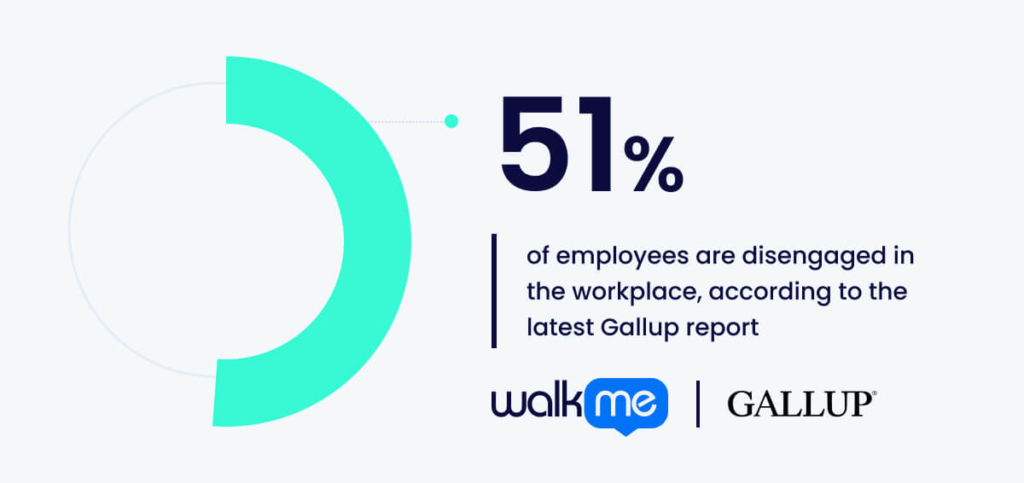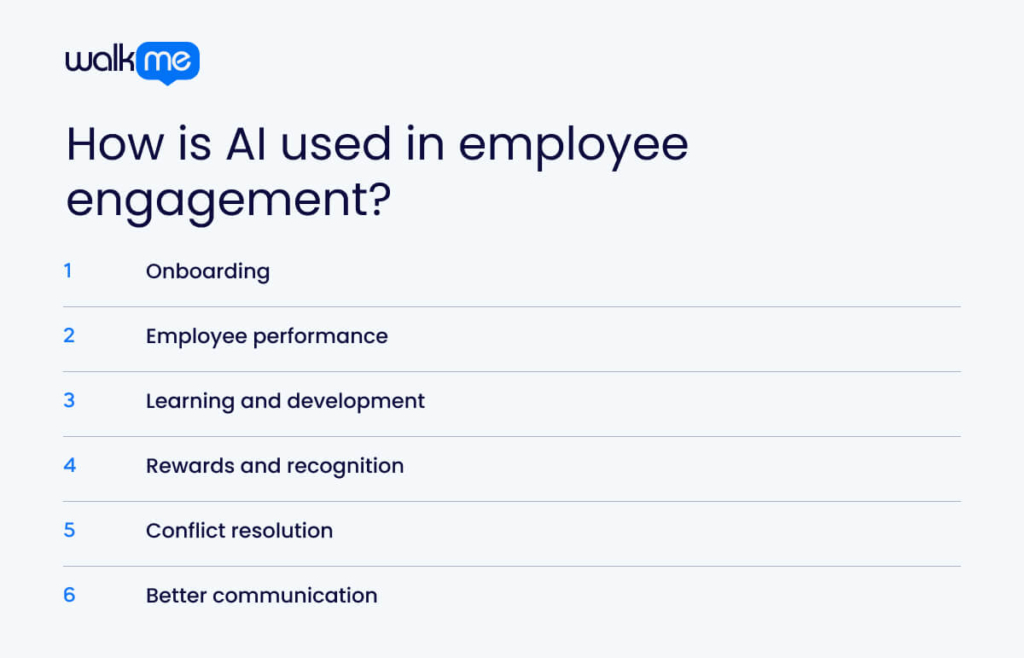AI is reshaping employee engagement with pinpointed insights and timely feedback that support a more responsive, fulfilling workplace.
For example, AI-driven surveys can instantly gauge team morale or detect early burnout signs. Managers can quickly act on these insights, improving work and family and creating a stronger sense of belonging.
Recent data shows that AI users report noticeable boosts in engagement in the following metrics. Work-life balance by 26%, a sense of belonging by 32%, and job satisfaction by 31%. These shifts are more than numbers—they’re efforts toward better productivity and a workplace that meets employee needs in real time.
This article will explore AI in employee engagement. We will start with a definition, and look at the limitations of traditional engagement methods, their impact, how it is used, and how to apply it to specific HR functions.
What is AI in employee engagement?
AI in employee engagement is the use of computer programs to collect and analyze information about how employees feel and what they do at work.
For example, employee experience software can analyze comments from engagement surveys, identify trends, and flag issues like burnout or low morale. They also use predictions to show managers what employees might need.
This lets companies quickly make changes to help employees balance work and life, feel a sense of belonging, and stay satisfied with their jobs.
Overall, AI in employee engagement enables companies to adapt to employee training needs by examining feedback and behaviors. It then provides real-time insights for a more responsive and supportive workplace.
What are the limitations of traditional employee engagement?
Traditional employee engagement methods often fail. According to the latest Gallup report, 51% of employees are disengaged in the workplace.

Companies usually rely on surveys or annual reviews that fail to capture the day-to-day experience of employees.
These methods treat all workers the same and often ignore unique needs and challenges. Without real-time data, companies can’t fix problems like low morale or employee burnout before they become serious issues.
This outdated approach makes it difficult for managers to address the changing concerns of the modern workforce. As a result, companies struggle to improve work-life balance, job satisfaction, and overall employee experience.
What is the impact of AI on employees?
As businesses adopt AI en masse, the impact on employees becomes more pronounced.
AI offers clear advantages, such as automation. However, it also warrants concerns about job displacement as certain roles become redundant.
Let’s explore the positive and negative impacts of AI on employees:
Positive impact of AI on employees
AI brings clear benefits that improve job satisfaction. Automating repetitive tasks means employees can focus on more meaningful work, making their roles more engaging.
AI improves team communication and collaboration. It streamlines workflows to support hybrid teams and cross-functional groups. AI makes it easier for teams to stay connected, nurturing cooperation and a more productive environment.
Negative impact of AI on employees
AI does introduce concerns about job displacement. Some roles may change or disappear as tasks become automated, creating uncertainty. This can lead to anxiety over job security and morale.
Upskilling is essential to address these challenges. Companies must offer training programs that help employees adapt to working with AI. These resources are necessary for employees to stay caught up, creating a skills gap that could limit their career potential.
How is AI used in employee engagement?

Now that you know AI’s limitations and impact on employee engagement, it is time to discover how it is actually used.
According to McKinsey, organizations using AI have seen engagement increases of up to 40% in certain functions.
Firms that understand how AI tools function can optimize engagement plans. This ensures employee needs and business goals align better.
Let’s take a closer look at how AI is used in employee engagement:
Onboarding
Starting a new job can be overwhelming, but AI makes employee onboarding much smoother.
Smart software creates personalized employee training courses and HR information for each new hire, helping them get comfortable. AI can also track how engaged and supported new employees feel, identifying areas where they might need extra help.
Instead of generic onboarding, the AI approach ensures every new worker feels welcomed and informed from their first day. The goal is to get them up to speed fast so they can start contributing to the team.
Employee performance
AI is central in monitoring and improving how employees perform at their jobs. AI tools collect data from all kinds of sources. This includes the outcomes of projects they’ve worked on, feedback from their peers, and self-assessments they’ve completed.
This gives the AI a well-rounded view of each employee’s strengths and weaknesses. It can then provide them with personalized feedback and advice on getting better. Managers also use AI insights to make smarter decisions about promotions, development plans, and performance reviews. The aim here is to create a culture where everyone is continuously improving.
Learning and development
AI customizes learning and development programs to fit each employee’s needs. It can analyze their past performance, current skills, and future career goals. Then, it recommends relevant training courses, educational resources, and growth opportunities tailored just for them.
A personalized approach keeps people engaged and helps them retain what they’ve learned better than traditional training programs. HR teams can also use AI data to promote a culture where employees always expand their capabilities and work towards their next step.
Rewards and recognition
AI is changing the way companies reward and recognize their employees. Employee experience platforms analyze individual achievements, contributions to the team, and feedback to ensure timely and personalized recognition.
Instead of generic awards, AI ensures people are acknowledged for their efforts based on real data. The software also tracks which rewards are most motivating for different employees. This data-driven approach creates a more engaged and satisfied workforce that feels valued for their unique strengths.
Conflict resolution
AI supports resolving workplace conflicts by offering impartial, data-driven insights. Digital tools can analyze communication patterns to identify potential issues before they escalate. For example, the AI might detect negative tones or tension building up in email exchanges and suggest ways to address the problem.
If full-blown conflicts arise, the AI can recommend fair and effective solutions based on how similar situations have been resolved. This technology helps HR teams manage disputes proactively. It ensures employees feel supported and that the process is transparent and equitable.
Better communication
AI improves overall organizational communication management by simplifying processes and allowing more useful interactions. AI assistants can handle tasks like scheduling meetings, filtering important information, and directing employees to the right resources when they have questions.
Analytics allow the AI to track communication trends, helping HR teams understand where gaps exist and what improvements can be made. The result is more efficient, transparent communication that stimulates a more connected work environment.
How to apply AI in employee engagement
We’ve just reviewed use cases of AI in employee engagement. Now, it’s time to learn how to apply it.
Applying AI to employee engagement is essential for companies that want to stay competitive. A big part of this is learning to do so properly, keeping cause and effect in mind. Converging big data and machine learning with human touch is the key to effectively using AI for retention and engagement.
It’s not enough to just implement AI tools. Companies must align them with their specific goals, culture, and employee needs.
Let’s explore how to apply AI in employee engagement:
Employee support through virtual assistants
HR teams can use AI to create virtual assistant chatbots that provide 24/7 help for employees. These bots can answer questions about company policies, guide people through HR processes like signing up for benefits, and give instant responses about things like payroll or time off. This always-available support reduces frustration and liberates HR staff to focus on more strategic work. The aim is to ensure employees can access the information they need swiftly, at any time.
Instant feedback and recognition
AI delivers immediate, personalized feedback and recognition to boost employee engagement. Employee engagement platforms automatically track things like project completions and positive attitudes. They can then instantly notify both the employee and their manager.
This shows people their contributions are valued and appreciated in the moment, not just during annual reviews. It creates a culture where everyone feels recognized for their efforts and is motivated to keep improving.
Streamlined performance management
Applying AI to performance management helps HR streamline the process, from setting goals to conducting evaluations. Smart tools monitor employee performance across different metrics, providing data-driven reports.
This eliminates bias in traditional reviews. Managers can use the insights to create tailored development plans, track progress, and have more focused check-ins with their teams. The result is an efficient and fair performance management system.
Customized learning and development
AI can create personalized learning experiences that match each employee’s career goals and skills. HR teams use AI platforms to analyze past performance, learning styles, and future aspirations. Then, the AI recommends targeted training programs or courses.
This could be a leadership development class for employees with management potential. A customized approach helps people grow at their own pace and be equipped with the right skills to meet the company’s needs.
Predictive analytics for employee wellness
AI-powered predictive analytics allow HR to monitor and support employee wellness. The software analyzes patterns in work habits, sick days, and engagement levels. This helps identify burnout or other wellness concerns before they become problems.
For example, the AI might flag employees showing signs of stress or disengagement so HR can step in with targeted wellness programs or extra support. A data-driven approach helps create a healthier, more engaged workforce that experiences less turnover.
How does AI analytics enhance employee engagement strategies?
AI analytics play an important role in driving employee engagement. Analytics provide a window into the nuances of employee engagement. They enable HR teams to create engagement strategies based on data and continuously test the results.
This way, HR managers can pivot if a certain element of the strategy isn’t working. Analytics also helps identify specific problem areas so the whole strategy doesn’t need to be overhauled.
Let’s take a look at how AI analytics enhance employee engagement strategies:
Discovering valuable insights
AI analytics can uncover important insights about employee engagement that may not be obvious from traditional surveys or reviews. For example, sentiment analysis reveals hidden patterns in how satisfied or motivated people are, even if they don’t express it directly.
HR teams can use these insights to understand what’s affecting engagement, whether it’s workload, leadership, or company culture. This data allows them to make more informed decisions and fine-tune their engagement strategies to meet employee needs.
Identifying factors that drive engagement
AI analytics helps pinpoint the specific factors that have the biggest impact on employee engagement. It looks at data from surveys, performance reviews, and work environments.
For example, the AI might find a link between high engagement and certain management styles or work schedules. This allows HR to focus efforts on the most important drivers of engagement, like improving communication or creating more opportunities. The goal is to ensure engagement initiatives are as effective and targeted as possible.
Instant feedback and actionable data
AI analytics gives HR teams real-time data to adjust engagement strategies. The software can track employee feedback and sentiment so HR can spot issues before they become bigger problems.
This allows them to take immediate action, like providing extra training or resources, to keep engagement high. Having this actionable data at their fingertips empowers HR to be more responsive and proactive in supporting their employees.
Customized recommendations
AI analytics can generate personalized suggestions for improving each employee’s engagement. The software analyzes an individual’s work patterns, communication style, and past feedback to recommend tailored strategies.
This might include suggesting specific development opportunities or adjusting schedules to improve work-life balance. HR teams can use these insights to design engagement initiatives that resonate with every employee’s needs and preferences.
Ongoing improvement
AI analytics helps HR teams improve their employee engagement efforts. The software tracks and analyzes data on sentiment, performance, and feedback. This provides a steady flow of information so HR can assess whether current initiatives are working and identify areas that need refinement.
For example, if a program isn’t driving the desired results, AI can help pinpoint the exact issue. Whether it’s the recognition, training, or collaboration aspects, it allows for an evolving engagement strategy that stays effective over time.
Targeted support interventions
AI analytics enables HR to identify employees who may need extra support before they become disengaged. The software can detect warning signs like reduced productivity, increased absences, or negative feedback.
When these trends are spotted, HR can offer personalized help, such as coaching, career guidance, or wellness programs. This approach means employees have the resources to stay engaged and motivated.
Promoting employee well-being
AI analytics plays a key role in promoting overall employee wellness. The software can track workload, working hours, and sentiment to spot signs of burnout or other health issues.
With this data, HR can implement proactive well-being initiatives, like flexible schedules or mental health support, before problems escalate. These strategies help encourage a work environment prioritizing employee health and wellness.
Embracing AI for enhanced employee engagement
AI is bolstering employee engagement like never before. Data-driven insights give HR teams unprecedented access to real-time feedback, helping them understand employee sentiment and preferences with greater accuracy.
Advanced tools expose hidden patterns in satisfaction and motivation so HR can fine-tune strategies for maximum impact. This constant feedback allows quick adjustments, keeping the workforce aligned and enthused.
Introducing AI specifically for employee engagement positions organizations to thrive in an uncertain future.
Remember that a motivated and engaged team is the key to a powering-up your HR impact. Tapping into the power of AI is key to creating a workplace where people can freely contribute and succeed.
FAQs
AI can analyze all kinds of data about employee engagement, like survey responses and performance records. This helps spot hidden patterns, such as people in certain teams seeming less satisfied. With these data-driven insights, HR teams can make smarter decisions about improving engagement. The software also gives valuable information on how employees behave so organizations can fine-tune their plans to keep people motivated.
Generative AI can give personalized advice to help employees work better and stay engaged. It can identify people’s strengths and weaknesses and recommend training to help them grow. This empowers people to contribute and thrive, boosting engagement and job satisfaction.

